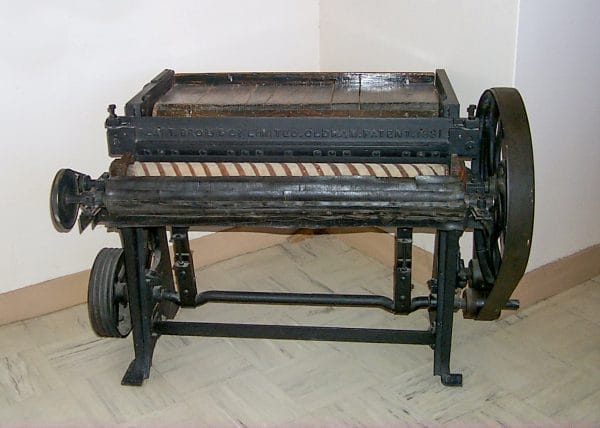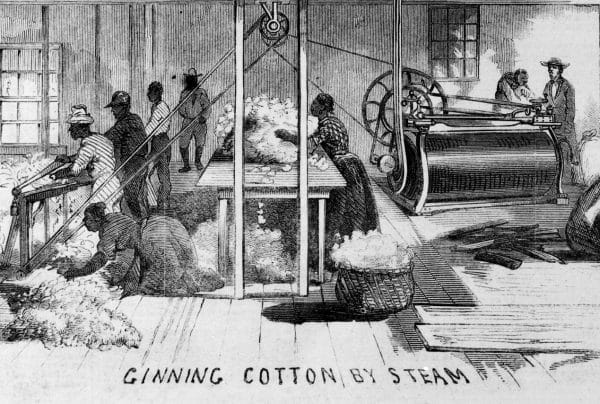Fones McCarthy
 Fones McCarthy Cotton Gin
A New Yorker by birth and a machinist by trade, Fones McCarthy (born 1800 or 1807, according to various sources) patented an innovative cotton gin that brought international recognition to Demopolis, Marengo County. McCarthy characterized himself as a “master mechanic” and an “inventor” but he was foremost an enigma. He was 38 and married with a son and two daughters all under 10 when he moved to the South from Utica, New York. Utica was an epicenter of reform that nurtured evangelists, abolitionists, and anti-Mason and temperance advocates in the early nineteenth century. Four miles west of Utica, in Whitesboro, George W. Gale established the interracial Oneida Institute, a manual-labor school that trained students for the ministry. Utica was also home to engineers who worked on the Erie Canal, eight miles south. How this dynamic environment influenced McCarthy can only be imagined. Born about 1800, he could have worked on the canal when it passed through Utica in 1819 or heard evangelist Charles G. Finney, a friend of George Gale, preach there in the early 1830s.
Fones McCarthy Cotton Gin
A New Yorker by birth and a machinist by trade, Fones McCarthy (born 1800 or 1807, according to various sources) patented an innovative cotton gin that brought international recognition to Demopolis, Marengo County. McCarthy characterized himself as a “master mechanic” and an “inventor” but he was foremost an enigma. He was 38 and married with a son and two daughters all under 10 when he moved to the South from Utica, New York. Utica was an epicenter of reform that nurtured evangelists, abolitionists, and anti-Mason and temperance advocates in the early nineteenth century. Four miles west of Utica, in Whitesboro, George W. Gale established the interracial Oneida Institute, a manual-labor school that trained students for the ministry. Utica was also home to engineers who worked on the Erie Canal, eight miles south. How this dynamic environment influenced McCarthy can only be imagined. Born about 1800, he could have worked on the canal when it passed through Utica in 1819 or heard evangelist Charles G. Finney, a friend of George Gale, preach there in the early 1830s.
 Fones McCarthy Patent Drawing
McCarthy moved to Demopolis in 1838, one year after cotton prices began a precipitous decline. Farmers blamed the saw gin, which they used to separate the cotton fiber from the seed, for the depressed market. The sharp teeth of the saws broke the fiber as they ginned, turning out short, irregular lengths, whereas textile manufacturers preferred long fibers of uniform length. McCarthy demonstrated to the farmers of the fertile Tombigbee–Black Warrior River Valley that his new gin would deliver just that. In 1840, he patented his “Smooth Cylinder Cotton-Gin.” It had one large, textured roller that seized the fiber and pulled it under a stationary blade as a reciprocating blade knocked off the seed. The hardships of an economic depression delayed production, but in 1842 farmers organized the Demopolis Manufacturing Company to subsidize the manufacture of the gin. McCarthy may have used their services, but he also had gins made in New Jersey, Connecticut, South Carolina, and Florida, where he moved in 1847. The gin’s popularity fluctuated, but by 1850 it had found a niche in the small but profitable Sea Island cotton market. In 1854, McCarthy successfully applied for a seven-year extension of the patent. After it expired in 1861, British manufacturers monopolized production and distributed the gin to short- and long-staple cotton growers throughout the British Empire. Their aggressive marketing explains why, until the late twentieth century, most cotton producers outside the United States used what became known as the “McCarthy gin” and associated it with Demopolis, the inventor’s home when he patented it.
Fones McCarthy Patent Drawing
McCarthy moved to Demopolis in 1838, one year after cotton prices began a precipitous decline. Farmers blamed the saw gin, which they used to separate the cotton fiber from the seed, for the depressed market. The sharp teeth of the saws broke the fiber as they ginned, turning out short, irregular lengths, whereas textile manufacturers preferred long fibers of uniform length. McCarthy demonstrated to the farmers of the fertile Tombigbee–Black Warrior River Valley that his new gin would deliver just that. In 1840, he patented his “Smooth Cylinder Cotton-Gin.” It had one large, textured roller that seized the fiber and pulled it under a stationary blade as a reciprocating blade knocked off the seed. The hardships of an economic depression delayed production, but in 1842 farmers organized the Demopolis Manufacturing Company to subsidize the manufacture of the gin. McCarthy may have used their services, but he also had gins made in New Jersey, Connecticut, South Carolina, and Florida, where he moved in 1847. The gin’s popularity fluctuated, but by 1850 it had found a niche in the small but profitable Sea Island cotton market. In 1854, McCarthy successfully applied for a seven-year extension of the patent. After it expired in 1861, British manufacturers monopolized production and distributed the gin to short- and long-staple cotton growers throughout the British Empire. Their aggressive marketing explains why, until the late twentieth century, most cotton producers outside the United States used what became known as the “McCarthy gin” and associated it with Demopolis, the inventor’s home when he patented it.
 Steam-Powered McCarthy Gin
McCarthy’s reasons for leaving Utica are unknown, as are his reasons for choosing Demopolis, but economics drove his decision to move to Florida. It may also have driven his decision to purchase an enslaved person, as well. In 1860, McCarthy owned a 35-year-old man who may have helped him in his shop. Census records indicate he lived alone in 1860 and in 1870, when census marshals valued his estate at $10,000. Seventy years old, he claimed three gin-related patents and international fame. McCarthy never advertised and appears to have left no writings apart from his patent extension application, which included a business history and affidavits from colleagues and customers. His memory lives on in his gin, used by engineers today to process the highest quality cotton for industrial and upscale apparel uses.
Steam-Powered McCarthy Gin
McCarthy’s reasons for leaving Utica are unknown, as are his reasons for choosing Demopolis, but economics drove his decision to move to Florida. It may also have driven his decision to purchase an enslaved person, as well. In 1860, McCarthy owned a 35-year-old man who may have helped him in his shop. Census records indicate he lived alone in 1860 and in 1870, when census marshals valued his estate at $10,000. Seventy years old, he claimed three gin-related patents and international fame. McCarthy never advertised and appears to have left no writings apart from his patent extension application, which included a business history and affidavits from colleagues and customers. His memory lives on in his gin, used by engineers today to process the highest quality cotton for industrial and upscale apparel uses.
Further Reading
- Lakwete, Angela. Inventing the Cotton Gin: Machine and Myth in Antebellum America. Baltimore, Md.: Johns Hopkins University Press, 2003.
- Mayfield, W. D., R. V. Baker, and W. S. Anthony. Introduction to a Cotton Gin. Memphis, Tenn.: National Cotton Ginners Association, 1990.



